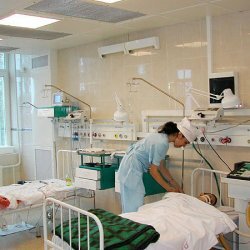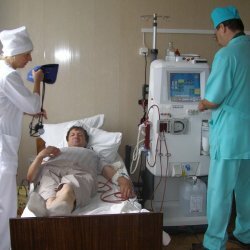Idiopathic pulmonary fibrosis: what is it, symptoms, treatment, prognosis
Content
- What is idiopathic pulmonary fibrosis?
- Causes of idiopathic pulmonary fibrosis
- Symptoms of idiopathic pulmonary fibrosis
- Diagnostics
- Treatment for idiopathic pulmonary fibrosis
- Lifestyle changes
- Home oxygen breathing apparatus
- Medications
- Pulmonary rehabilitation
- Lung transplant
- Forecast
What is idiopathic pulmonary fibrosis?
Idiopathic Pulmonary Fibrosis (IPF) Is the type lung diseasescausing scarring (fibrosis) of the lungs for no known reason. Over time, the scars get worse, it becomes difficult for the patient to take a deep breath, and the lungs cannot absorb enough oxygen.
IPF is a form of interstitial lung disease that mainly involves the interstitium (tissue and space around air sacs of the lungs), and does not directly affect the respiratory tract or blood vessels. There are many other types of interstitial lung disease that can also cause inflammation and / or fibrosis.
Causes of idiopathic pulmonary fibrosis
Cause of idiopathic pulmonary fibrosis not fully understood. Nobody knows what causes the disease or why some people get it. Common risk factors for IPF include:
- Genetics (family history): up to 20% of people with IPF have another family member with interstitial lung disease. If more than one family member has IPF, the disease is called familial pulmonary fibrosis.
- Smoking cigarettes: Approximately 75% of people with IPF are current or previous smokers.
- Acid reflux (gastroesophageal reflux disease [GERD]): approximately 75% of people with IPF have acid reflux symptoms or heartburn.
- Male gender: Approximately 75% of IPF patients are men.
- Age: almost all patients with IPF are over 50 years old
Symptoms of idiopathic pulmonary fibrosis

The two main symptoms of idiopathic pulmonary fibrosis are:
- Dyspnea (also known as dyspnea or shortness of breath): Usually, shortness of breath for IPF first appears during physical activity. Dyspnea may affect daily activities such as showering, climbing stairs, dressing, and eating. As the scarring in the lungs worsens, shortness of breath can interfere with any activity.
- Chronic cough. About 85% of people with IPF have a chronic cough that lasts more than 8 weeks. The cough is often dry, but some people cough with phlegm.
Other symptoms may include:
- chest pain or tightness;
- unexplained weight loss;
- loss of appetite;
- tiredness and loss of energy;
- a change in the shape of the finger, called the "fingers of the hippocrates."
Diagnostics
Idiopathic pulmonary fibrosis can be difficult to diagnose because many lung diseases can cause shortness of breath and cough, and some of these other conditions may have similar symptoms and radiological findings research. The patient may need to see several specialists, including a pulmonologist, to help with the diagnosis.
- The doctor will ask the patient questions about the home and work environment, smoking history and medical history. This will help him determine if there were any environmental, occupational, genetic, or other factors that could be associated with the development of pulmonary fibrosis.
- The doctor will physically examine the lungs and also examine other parts of the body, including the heart, joints, nails, skin, and muscles.
Read also:Tachypnea
Although no test can diagnose idiopathic pulmonary fibrosis, a doctor may recommend a number of different tests, including:
- Pulmonary function test (LFT): The TLF, or breath test, is a simple test to measure how much air a person can breathe in and out, and how much oxygen can be absorbed by the lungs.
- 6-minute walk test: The test helps to determine the patient's physical condition, as well as the amount of oxygen in the blood at rest and during physical activity.
- Chest X-ray: A chest X-ray is a simple projection chest X-ray that can be used to detect interstitial lung disease and can sometimes be helpful in monitoring progression diseases.
- Blood tests: A number of blood tests may be needed to determine other causes of interstitial lung disease.
- Computed tomography (CT): Diagnostic methods that give a complete picture of the condition of the body show the presence of scarring in the lungs and help determine the subtype of interstitial lung disease.
- Bronchoscopy. A bronchoscopy is a procedure in which a small flexible tube called a bronchoscope is inserted through the mouth or nose into the lungs. The procedure is not required for diagnosis, but some patients with possible IPF undergo this procedure. to help identify the presence of an infection or suggest other subtypes of interstitial disease lungs.
- Surgical lung biopsy. Patients with an unclear diagnosis sometimes undergo a surgical lung biopsy performed by a surgeon under general anesthesia. This test includes small incisions in the lateral surface of the chest, which allows the lung tissue to be removed and examined in the laboratory under a microscope.
Treatment for idiopathic pulmonary fibrosis

IPF is untreated, and there are currently no procedures or drugs that can remove scarring from the lungs. The procedures are used to slow the progression of scarring of the lungs and do not necessarily reduce the symptoms of cough and shortness of breath.
Pirfenidon (Esbriet) and Nintedanibhas been shown to slow the progression of idiopathic pulmonary fibrosis; However, some patients are unable to take these medications due to their side effects. These medicines are not approved for use in other interstitial lung diseases.
Some additional medications can also be used to improve symptoms of IPF, such as shortness of breath and coughing. These include treating gastroesophageal reflux with acid therapy and treating shortness of breath with opioids (a class of drugs that includes morphine). Other treatments include supplemental oxygen, pulmonary rehabilitation (exercise training, education and support for people with chronic lung disease), and lung transplants.
Read also:Emphysema of the lungs: what is it, causes, symptoms and treatment
Lifestyle changes
IPF is an irreversible, progressive disease. Therefore, it is important to learn good coping skills and learn as much as possible about the disease.
- Quitting smoking is the most important thing you can do to help slow the progression of any lung disease.
- Get a flu shot every year.
- Ask your doctor about the vaccine against pneumonia.
- Stay away from people with chest infections and colds.
- Wash your hands thoroughly and often.
Home oxygen breathing apparatus

Scars in the lungs can prevent the body from absorbing oxygen. Low oxygen levels can cause shortness of breath and fatigue. If the oxygen level in your blood is too low, your doctor may prescribe supplemental oxygen (home oxygen breathing apparatus). It helps reduce shortness of breath and can help you be more active. Some people with idiopathic pulmonary fibrosis may need oxygen therapy all the time, while others may only need it during exercise or sleep.
If your doctor prescribes supplemental oxygen, it is important to use it as directed. Many patients fear that they will become "addicted" to supplemental oxygen. The supplemental oxygen is not addictive and the body only needs the amount it needs to maintain normal bodily functions. People who are taking supplemental oxygen should continue to take their medications.
Not everyone with IPF needs to be on an oxygen machine. Typically, oxygen therapy can only help people with very low oxygen levels in their blood (hypoxemia). To find out if you need supplemental oxygen, talk to your doctor.
Medications
There is no medication to heal IPF or reduce the amount of scarring in the lungs. However, some medications help slow the progression of pulmonary fibrosis.
It is very difficult to find medicines that work for everyone with IPF. Medications for idiopathic pulmonary fibrosis cause side effects in some patients, so it's important to talk to your doctor about the potential risks.
As with any medicine for any medical condition, the patient should talk to the doctor about the different treatment options and ask about the side effects of the medicine.
Pirfenidon.
Pirfenidone is an anti-scar drug (anti-fibrotic) that slows the progression of IPF. Some patients taking pirfenidone have side effects, most commonly upset stomach and skin rashes, especially when exposed to the sun. Pirfenidone has been approved for the treatment of mild to moderate IPF.
Read also:Cystic fibrosis disease: causes, symptoms, diagnosis and treatment
Nintedanib.
Nintedanib is an anti-scar (anti-fibrotic) drug that slows the progression of IPF. Some people taking nintedanib have side effects, most commonly diarrhea.
Corticosteroids (tablets).
Corticosteroids (such as prednisone) can reduce inflammation in the lungs by suppressing the immune system. Corticosteroids are only used in IPF patients who have an acute exacerbation of pulmonary fibrosis, and may be harmful to IPF patients whose scars are stable or slowly worsening.
N-acetylcysteine (oral or aerosol).
N-acetylcysteine (ACC, Mukomist) is an antioxidant commonly used in patients with IPF. However, a large clinical study published in May 2014 showed that acetylcysteine does not slow the progression of the disease.
Pulmonary rehabilitation
Pulmonary Rehabilitation is an exercise and education program designed specifically for patients with lung conditions. Pulmonary rehabilitation can help teach IPF patients how to breathe more efficiently and perform their daily activities with less breathing.
Although most pulmonary rehabilitation programs are for people with COPD (emphysema and chronic bronchitis), they are great for people with idiopathic pulmonary fibrosis.
Lung transplant
Lung transplant is not suitable for everyone, but it may be a treatment option for some people. It's important to work with your doctor to find out if a lung transplant is right for you.
If a person is eligible for a lung transplant, they are placed on a waiting list for organ donation. The wait can be long and the operation can be risky. People who have received organ transplants must take anti-rejection medications (immunosuppressants) for the rest of their lives.
Forecast
Idiopathic pulmonary fibrosis portends a poor prognosis. In terms of life expectancy for idiopathic pulmonary fibrosis, the estimated median survival is 2-5 years from diagnosis. The death rate is estimated at 64.3 deaths per million for men and 58.4 deaths per million for women.
Mortality among patients with IPF increases with age, in men it is higher than in women, and is prone to seasonal fluctuations, with the highest mortality rates observed in winter, even if infectious causes are excluded.
The most common causes of death in patients with IPF include acute exacerbations of idiopathic pulmonary fibrosis, acute coronary syndromes, congestive heart failure, lungs' cancer, infectious causes and venous thromboembolic disease.



